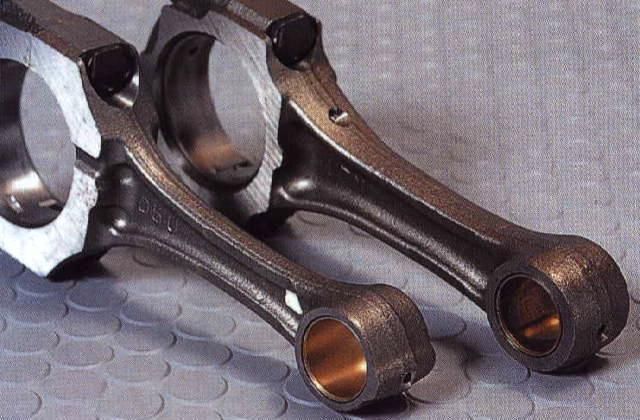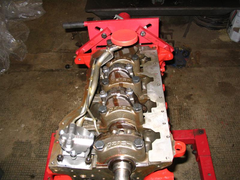
Engine oil lubrication system
bikecarbfred - 7/12/15 at 08:35 PM
We have an engine block. No squirters for cylinders walls and no pressurized oil feed for the piston pin. Everything relies on splish splash.
The crankshaft sits above the oil sump. When oil level is to the max level, the centre of the crank sits 7cm above the oil. When the crank rotates the
big fins on the crankshaft would just skim or not even that along the oil when oil is at max level.
How can you get splish splash from that? Someone told me that it is like a hurricance down there.
The only way I can see them catching and splishing everything is when the car is being driven and oil in the sump is going left to fight back and
forth. But what happens when the car is sat idle.
I am sure i'm missing something but I always thought the cranks splash into the oil in the sump 
Nickp - 7/12/15 at 10:18 PM
Oil will be squirting out of each big end bearing and 'splishy splashing' around 
Dusty - 8/12/15 at 12:01 AM
' I always thought the cranks splash into the oil in the sump '
Cranks do not and must not do this. It would thrash the oil to a foam and all the rotating bearings would end up being fed mostly air.
bi22le - 8/12/15 at 08:23 AM
Oil will be going on every surface. It will be splashing up the sides and all sorts.
In my head i have the idea that modern engines dont allow the balance bells to hit the pan oil as it uses energy and reduces performance. I would say
that (depending on engine designer) trust what they have done.
Regarding hurricain down there comment. I would say so. Oil mist, 5k RPM of rotating metal and being thrown around, there wont be a dry part.
Nickp - 8/12/15 at 08:41 AM
quote:
Originally posted by bi22le
Regarding hurricain down there comment. I would say so. Oil mist, 5k RPM of rotating metal and being thrown around, there wont be a dry part.
Agreed, it'll be wetter than an otters pocket in there 
snapper - 8/12/15 at 10:21 AM
Notching the rod is an option

Used when fitting Cosworth rods to a Pinto without the Cosworth pump and spray bar
DW100 - 8/12/15 at 10:38 AM
The normal way is that the oil pump pumps oil up to the main bearings, from there it travels through drillings inside the crank to the big ends and as
can be seen on the top rod in the picture above through drilled holes to spray at the bottom of the piston. Neither the main bearing or the big ends
are sealed at the side, so oil spills from the sides and is thrown about by the rotational forces of the crank.
The crank should not be in the oil. I once heard David Vizard describe it as the crank belly flopping onto the oil at 7000 RPM. You could imagine the
forces involved breaking the crank.
Theshed - 8/12/15 at 11:00 AM
The howling gale in the sump is not just caused by the crank but also the pistons moving up and down shifting the air around. It actually wastes a lot
of power hence folk knife edging the lobes of the crank and radiusing the block to improve the aerodynamics (that is hardcore!). Use of scavange pumps
on a dry sump system also improves power output for the same reason - less air to move around if you are running a vacuum.
In a moment somebody running an Austin 7 engine will pop up to talk about the spit and hope crank lubrication system....
mcerd1 - 8/12/15 at 12:58 PM
quote:
Originally posted by snapper
Notching the rod is an option
Used when fitting Cosworth rods to a Pinto without the Cosworth pump and spray bar
^^ but in that case its just easier to fit a cossie 2wd pump and spray bar 


bottom end built :D
bikecarbfred - 8/12/15 at 10:17 PM
So from what I learnt is that in my type of engine it is imperative that the oil feeds in the crank and also the oil feeds in the block feeding into
the crank bearings are totally free because this is the only way I will get the splish splash (through the side of the main bearing - squirting and
spiraling like a catherine wheel firework effect).
So with these blocked not only will it ruin the crank but can also ruin the cylinder walls. So a total fail of the engine in one go.
redturner - 8/12/15 at 10:47 PM
quote:
Originally posted by Theshed[/i
In a moment somebody running an Austin 7 engine will pop up to talk about the spit and hope crank lubrication system.... [/quote
or those of us old enough to remember the old stationary engines, Petter, Lister etc with the old quill dippers, but they always seemed to work..... I
just tried to post a picture of a dry sump pan that we make for modern engines to try to illustrate, but failed. It went into the forum header but
that was it.....
Paul Turner - 9/12/15 at 10:16 AM
quote:
Originally posted by bikecarbfred
So from what I learnt is that in my type of engine it is imperative that the oil feeds in the crank and also the oil feeds in the block feeding into
the crank bearings are totally free
That applies to every engine made. When assembled all the parts must be scrupulously clean and then the correct grade of oil used and changed
regularly. Providing that is done the whole engine should be lubricated as intended.



